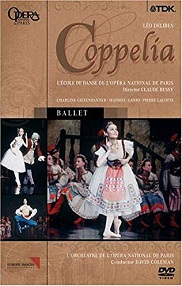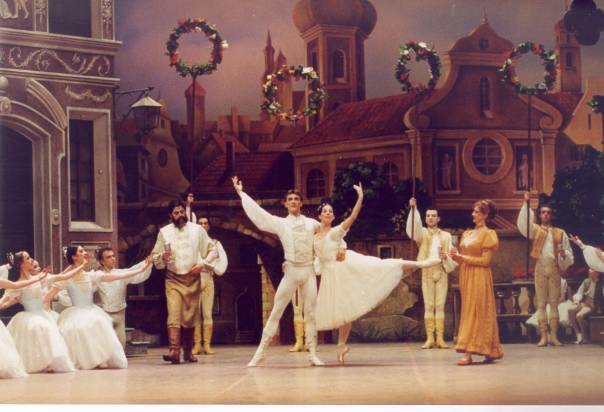COPPELIA
SUBJECTS — Dance/Performance;
SOCIAL-EMOTIONAL LEARNING — Romantic Relationships;
MORAL-ETHICAL EMPHASIS — Respect.
AGE: 5+; No MPAA Rating;
Ballet; There are several versions available. Available from Amazon.com.
There is NO AI content on this website. All content on TeachWithMovies.org has been written by human beings.

SUBJECTS — Dance/Performance;
SOCIAL-EMOTIONAL LEARNING — Romantic Relationships;
MORAL-ETHICAL EMPHASIS — Respect.
AGE: 5+; No MPAA Rating;
Ballet; There are several versions available. Available from Amazon.com.
Set in a Polish village at the end of the 18th century, this ballet classic follows the romantic high jinks of sweethearts Franz and Swanhilda. The young lovers are drawn into mischief by their fascination with the “daughter” of the mysterious doll maker, Dr. Coppelius. She appears only in the window of Dr. Coppelius’ shop, facing the village square, where the young people dance. Seated in a chair, Coppelia appears to be always reading a book. Franz is attracted to this new creature. Swanhilda observes his fascination and senses a rival. They resolve, separately, to investigate. In the workshop of Coppelius, each finds more and less than he or she expected. There are marvelous mechanical dolls that dance when touched. The doddering doctor invites Franz to drink with him and secretly puts a sleeping potion in the wine. Then, using magic incantations from an old book, he tries to draw the life force from Franz and transfer it to his adored creation Coppelia. Swanhilda obliges with an impersonation of the doll come to life. This is comic rather than menacing, with very readable pantomime moving the action along. The ballet concludes with a festive village wedding for the young pair. Folk dances (czardas and mazurka) enliven the classical ballet vocabulary. The music is by Leo Delibes. This ballet is fun for the whole family and deserves a wider audience.
Most current productions are updated versions of the 19th-century choreography of Arthur Saint-Leon and the grand master Marius Petipa. For example, the Fernando Bujones version, which showcases this dancer’s virtuosity, adds more dancing for Franz. The storyline is based on ETA Hoffmann’s tale, “Der Sandmann.”

This ballet, like its better-known cousin, The Nutcracker, is a delightful introduction for young children to classical dance. It can be used as an introduction to the function of fairy tales as giving expression to some fears that many children feel.

Minor. The girls use a key that Dr. Coppelius has dropped to gain entrance to the shop without his permission. Franz climbs in through a window. Franz accepts wine from a stranger, Dr. Coppelius. But this is all obviously fantasy, and parents who wish can turn these into benefits by simply pointing out to children, after the dance is over, that it is not a good idea to take food, candy, or drink from strangers and that these kids were very lucky that they were able to escape from Coppelius without injury or being hauled off to jail.
“Coppelia” has elements of dance and fairy tale. The best use of the film is to watch it with your children and to simply enjoy the dancing. This act, in itself, will expand their horizons. It might also be helpful to view this film before or after you have read fairy tales to your young children.
Some of the desires, fears and fascinations that interest children in this fairy tale are: (1) machines that can be made to be like people, i.e., robots; (2) a witch or sorcerer who will take the life force from someone who is asleep or who is drugged; (3) that just before a wedding the groom will get cold feet and go off with another woman; (4) mysterious old people can be sorcerers or witches; (5) the locked up room, shop, barn or store and the fascination is with what is inside; (6) the fear of what can happen to us when we are asleep or unconscious. There are probably several more.
For older children, parents might want to discuss the origins of modern ballet and the important contributions of Petipa and the Russian school of ballet, see Learning Guide to “The Red Shoes”
Leo Delibes (1836-1891) was a French composer who served as accompanist at the Paris Opera. Tchaikovsky admired his melodic, lushly orchestrated music. It was well suited to balletic interpretation. Delibes most successful ballets were Coppelia (1870) and Sylvia (1876). He is also remembered for his opera Lakme (1883).
1. See Discussion Questions for Use With any Film that is a Work of Fiction.
2. There is a theme in this dance of mechanical dolls coming to life. The eighteenth century was the beginning of the Industrial Revolution. What does that have to do with the dolls that appear so life-like in this story?
3. Name some other fairy tales about bringing inanimate objects to life? Why is this a frequent theme in fairy tales? What modern scientific development raises the same issues?
4. Which dancer did you like best? Why?
5. Which dance did you like best? Why?
6. Should Franz have accepted wine from Dr. Coppelius?
7. How would you feel about an older person who lived alone and kept to him or herself? What if this older person appeared to be able to make special or magical things?
8. How would you feel if you were Franz or Swanhilda and were just starting to climb into Dr. Coppelius’ darkened shop?
9. Why would people in the 17th or 18th centuries be captivated by the thoughts of mechanical dolls coming to life?
10. Did Franz have reasons to be suspicious of Dr. Coppelius?
1. How does this story show us the risks of jealousy?
2. How does this story show us the risks of curiosity?
3. How much of Franz’s fascination with Coppelia was based upon the fact that he was soon to be married to Swanhilda and he was feeling nervous about tying himself down? Is this a normal feeling for young men and women to have just before they are married?
Discussion Questions Relating to Ethical Issues will facilitate the use of this film to teach ethical principles and critical viewing. Additional questions are set out below.
(Treat others with respect; follow the Golden Rule; Be tolerant of differences; Use good manners, not bad language; Be considerate of the feelings of others; Don’t threaten, hit or hurt anyone; Deal peacefully with anger, insults, and disagreements)
1. Was it respectful for Franz and Swanhilda to break into Dr. Coppelius’ shop?